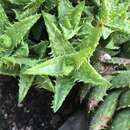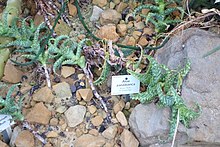tr
kırıntılardaki isimler


Aloe juvenna ist eine Pflanzenart der Gattung der Aloen in der Unterfamilie der Affodillgewächse (Asphodeloideae). Das Artepitheton juvenna ist eine pseudolateinisierte Form des Wortes ‚juvenil‘ und ist auf ein missdeutetes Etikett einer kultivierten Jungpflanze zurückführen.[1]
Aloe juvenna wächst stammbildend, ist reich verzweigt und sprosst von der Basis aus. Die dicht beblätterten Triebe sind aufrecht und dann bis zu 25 Zentimeter lang und 7 Millimeter im Durchmesser oder niederliegend sowie bis zu 45 Zentimeter lang und 1,2 Millimeter im Durchmesser. Die leuchtend grünen deltoiden, unterhalb der Triebspitze ausdauernden Laubblätter sind bis zu 4 Zentimeter lang und bis zu 2 Zentimeter breit. Je 10 Zentimeter Trieblänge sind bis zu 35 Laubblätter vorhanden. Auf der Blattoberfläche befinden sich viele verlängerte hellgrünen Flecken von denen viele zu kleinen Stachelchen ausgezogen sind. An den Blatträndern sitzen 4 bis 6 Millimeter voneinander entfernt, 2 bis 4 Millimeter lange knorpelige Zähne.
Der einfache oder einfach verzweigte Blütenstand erreicht eine Höhe von 25 Zentimetern. Die konische und ziemlich dichte Traube ist bis zu 8 Zentimeter lang und bis zu 6 Zentimeter breit. Ihre eiförmigen Brakteen sind etwa 5 Millimeter lang und 4 Millimeter breit. Die korallenrosafarbenen, an ihrer Spitze grünlich gelben Blüten werden von 13 bis 18 Millimeter langen Blütenstielen getragen. Sie sind 27 Millimeter lang, an ihrer Basis verschmälert und weisen auf der Höhe des Fruchtknotens einen Durchmesser von 8 Millimeter auf. Darüber sind die Blüten sehr leicht verengt und zur Mündung hin leicht erweitert. Die äußeren Perigonblätter sind auf einer Länge von 9 Millimetern nicht miteinander verwachsen. Die Staubblätter und der Griffel ragen kaum aus der Blütenhülle heraus.
Die Chromosomenzahl für Aloe juvenna ist 2 n = 28 {displaystyle 2n=28} 
Aloe juvenna ist in Kenia in dichtem Gras auf felsigen Rippen in Höhenlagen von 2300 Metern verbreitet. Sie ist nur von einem Fundort bekannt.
Die Erstbeschreibung durch Peter Edward Brandham und Susan Carter wurde 1979 veröffentlicht.[3]
Aloe juvenna ist eine Pflanzenart der Gattung der Aloen in der Unterfamilie der Affodillgewächse (Asphodeloideae). Das Artepitheton juvenna ist eine pseudolateinisierte Form des Wortes ‚juvenil‘ und ist auf ein missdeutetes Etikett einer kultivierten Jungpflanze zurückführen.
Aloe juvenna (The "Tiger-tooth Aloe") is a species of plant in the genus Aloe. It is popular in cultivation but extremely rare in its natural habitat in Kenya.[1]
It is endemic to Kenya in East Africa. Here it is restricted to a small rocky area in the mountainous south west of the country, near the border with Tanzania.
It has long been common in cultivation, but its origin was not known. The first recorded cultivated specimens were in South Africa, but although there were rumours that it had come from Kenya, its origins were a mystery even then. It was first believed to be a juvenile Aloe, due to its small size, and it was labelled "juvenna" ("juvenile") for this reason. However that label eventually became its formal name. Later, it was thought to be a hybrid perhaps of Aloe distans with Haworthia coarctata or a species of Astroloba.
It underwent genetic testing in the 1970s and, when it was discovered that Aloe juvenna had a doubled set of chromosomes (tetraploidy), it came to seem more likely that this Aloe came from East Africa, where most other tetraploid Aloes originate. The name Aloe juvenna was finally published as a valid species name in 1979. Finally, in 1982, an expedition in the far south west of Kenya discovered a few plants on a tiny rocky mountainous ridge, high about tropical rainforest. The existence of these plants in such a remote locality confirmed that the species was a natural one. However, how it originally came to be brought into cultivation in the first place, remains a mystery.[2][3]

Aloe juvenna is frequently confused with Aloe squarrosa from the island of Socotra. However Aloe squarrosa has long, smooth, spotted leaves that curve backwards. These recurved leaves are kept only around the head or top of each stem, with dead leaves falling off the lower parts of the stem. It is relatively rare in cultivation.
Aloe juvenna has many short, straight, compact triangular leaves, which are densely packed all along the stems. It is common in cultivation but extremely rare in habitat. Aloe juvenna is also a tetraploid, with a double set of chromosomes (28, instead of 14) and, in appearance, does not resemble any other Aloe species from the region.[4][5]
Aloe juvenna (The "Tiger-tooth Aloe") is a species of plant in the genus Aloe. It is popular in cultivation but extremely rare in its natural habitat in Kenya.
Aloe juvenna es una especie de planta suculenta perteneciente a la familia de los aloes. Es endémica de Kenia.[1]
Es una planta suculenta con las hojas agrupadas en una roseta basal. Las hojas son carnosas, largas y estrechas de color verde, moteada con manchas blancas y los márgenes armados con dientes.[2]
Aloe juvenna fue descrita por Brandham & S.Carter y publicado en Cactus and Succulent Journal of Great Britain 41: 27, en el año 1979.[3][4][2]
Aloe: nombre genérico de origen muy incierto: podría ser derivado del griego άλς, άλός (als, alós), "sal" - dando άλόη, ης, ή (aloé, oés) que designaba tanto la planta como su jugo - debido a su sabor, que recuerda el agua del mar.[5] De allí pasó al Latín ălŏē, ēs con la misma aceptación, y que, en sentido figurado, significaba también "amargo". Se ha propuesto también un origen árabe, alloeh, que significa "la sustancia amarga brillante"; pero es más probablemente de origen complejo a través del hébreo: ahal (אהל), frecuentemente citado en textos bíblicos.[6][7]
juvenna: epíteto latino que significa "juvenil".[8]
Aloe juvenna es una especie de planta suculenta perteneciente a la familia de los aloes. Es endémica de Kenia.
Aloe juvenna é uma espécie de liliopsida do gênero Aloe, pertencente à família Asphodelaceae.
Aloe juvenna é uma espécie de liliopsida do gênero Aloe, pertencente à família Asphodelaceae.
Aloe juvenna là một loài thực vật có hoa trong họ Măng tây. Loài này được Brandham & S.Carter mô tả khoa học đầu tiên năm 1979.[1]
Aloe juvenna là một loài thực vật có hoa trong họ Măng tây. Loài này được Brandham & S.Carter mô tả khoa học đầu tiên năm 1979.